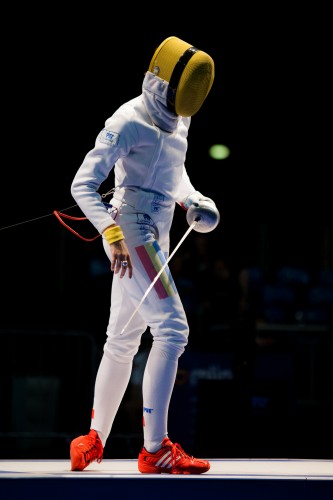“So, this goes…under the bra?” I stare dubiously at the hard plastic bowls.
“Yup,” says the 27-year-old Black Irish firefighter who somehow strikes me as unlikely to know, even though it is he who handed them to me in a sealed package upon which he has printed my name.
The trouble is I already have my heavy white canvas straightjacket zipped up to a high neck line in the back and the strap between my legs buckled to the rings at the middle of my back. I retreat to the ladies’ room with the only other lady present and we insert the domes. They feel decidedly unergonomic. Like if I were to take a hard hit to them they might spare the nipple but completely crush my lymph nodes.
I am in my first fencing class for a few reasons. First of all, my deep interest in combat sport has long been grappling with a deep lack of interest in injuring myself. Secondly, the Municipal Recreation Guide offered only a few other alternatives, such as scrapbooking and home-buying, for adults seeking new skills.
I have visions of springing about with my non-sword arm cocked, scorpion style behind and over my head – a throwback, it turns out, to a time when duels were fought with the visual aid of lanterns. Dueling died out after the First World War, and aristocrats stopped inoculating their children with fencing techniques, but the sport has lived on. In fact, it’s one of only four sports that has featured in every modern Olympics.
We start with foil fencing. According to sport scientists at National Taiwan College of Physical Education, the optimal angle of a foil handle is between 18˚ and 21˚, because this is the angle of a wrist least likely to sustain injury when stressed. I’m not so worried about wrist strain and more about things like what happened to the Soviet fencer Vladimir Smirnov in the 1982 World Championships in Rome. His West German opponent broke his blade off, and the sharp remainder tore through Smirnov’s mask, through his eyeball and into his brain. He died nine days later.
Only the torso is fair game for a foil strike (in contrast to the full-body epee rules), and if you both strike each other, it’s the fencer who initiated who takes the point. Being left-handed, I require separate instructions for every set of motions my fencing partner and I attempt. I get poked in the armpit a lot. There is a certain amount of nervous giggling. Now that we have our dark headgear on, I have to relearn everyone’s identities using trouser cues.
Fencing has been used as an exercise-only control in studies of mood enhancement of various activities. Whereas yoga relieves anxiety, it is found that fencing contributes only to a sense of improved vigor, rather than a stress reduction per se. My own reaction is one of bemusement: I have no idea how good I am.
That could be read the wrong way. What I mean to say is I have no idea whether or not I am any good. Where I stand on a scale of one to ten in fencing aptitude, I mean. I seem to be wired in the way that a larger proportion of women are, with regards to my ego orientation. Whereas someone with a disposition toward ego orientation will gauge his performance in relation to that of other people – his ranking below or else besting a field of opponents – I am more task oriented. I look at the task I am performing and try to do it well or quickly or whatever.
In a one-on-one combat sport like fencing, there is no well or quickly without regard to the person staring you down from behind their own sinister black oval mask. There is only the dance.
I return from class wondering when, if ever, I will be able to sense improvement, and what it might feel like. It is only when I get home that I realize I am still wearing my chest guards. They make a hollow sound when I knock. Perhaps between this week and next I can design some better ones. It could be something I’m good at.
Image: Ana Maria Branza of Russia competes in the 2013 European Senior Fencing Championships in Zagreb, Croatia. (Shutterstock)
